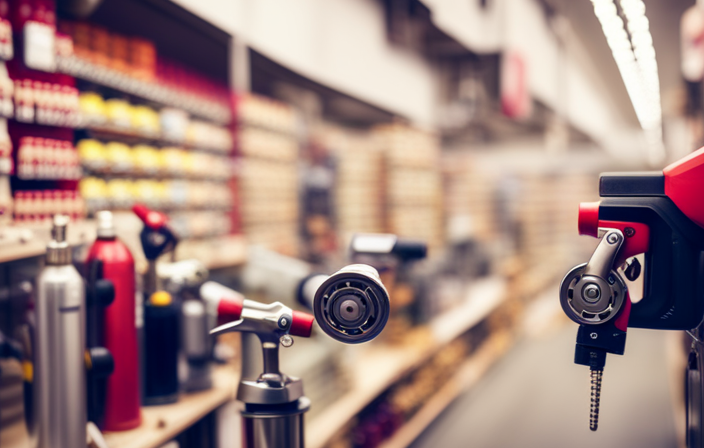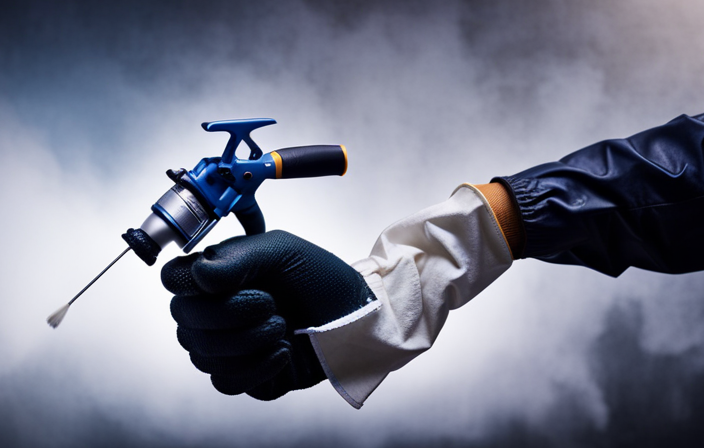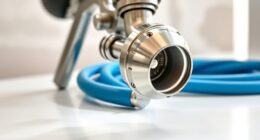For those of us who are passionate about refreshing furniture to give it a new look, I have found that using chalk paint with an airless paint sprayer is a game-changer. It is a rejuvenating experience for DIY enthusiasts like myself. The seamless and consistent finish achieved by an airless paint sprayer, combined with the versatility and charm of chalk paint, offers endless possibilities.
In this article, I will guide you through the process of using chalk paint with an airless paint sprayer, from preparing your surface to achieving a flawless finish. I will share tips and techniques to help you add texture and distress your piece for a unique, vintage look. We will also explore different ways to seal and protect your chalk-painted surface, ensuring its longevity.
Whether you’re a seasoned DIYer or just starting out, this article will equip you with the knowledge and inspiration to create stunning pieces using chalk paint and an airless paint sprayer. Let’s dive in and bring your furniture dreams to life!
Key Takeaways
- Achieving a smooth and even application by lightly sanding edges and experimenting with colors and layering
- Troubleshooting common issues such as clogging, uneven coverage, dripping or running paint, and paint splattering
- Benefits of using an airless paint sprayer, including achieving professional-looking results, saving time, evenly applying paint, and providing a smooth finish
- Techniques for creating different effects, such as a distressed vintage look, experimenting with colors and layering, adding intricate designs with stencils, and trying color-blocking or ombre effects.
Introduction to Chalk Paint and Airless Paint Sprayers
Are you ready to learn how to create beautiful, vintage-inspired furniture using chalk paint and an airless paint sprayer?
Chalk paint is a versatile and popular choice for DIY projects because of its unique matte finish and the ease with which it can be distressed.
When combined with an airless paint sprayer, the advantages of using chalk paint are even more pronounced. Unlike other types of paint for airless paint sprayers, chalk paint requires little to no prep work.
It adheres well to a variety of surfaces, including wood, metal, and even plastic. Additionally, the airless paint sprayer provides a smooth and even application, ensuring a professional-looking finish every time.
Now that you understand the benefits of using chalk paint with an airless paint sprayer, let’s move on to preparing your surface for its application.
Preparing Your Surface for Chalk Paint
Before starting your project, it’s important to prepare the surface properly for chalk paint. Begin by cleaning the surface to remove any dirt or debris. Once it’s clean, use sandpaper with a medium grit to gently roughen up the surface. This will help the paint adhere better. Focus on any rough or uneven areas that may require more sanding. After sanding, wipe down the surface with a damp cloth to remove any dust or residue. Taking the time to prepare your surface will ensure a flawless finish for your chalk paint project.
Now, let’s move on to choosing the right chalk paint and airless paint sprayer.
Choosing the Right Chalk Paint and Airless Paint Sprayer
To achieve a professional and polished result, it’s essential to select the right chalk paint and airless paint sprayer for your project. When choosing paint colors, consider the overall aesthetic and style of your space. Chalk paint offers a variety of shades, allowing for customization.
In addition to paint color, it’s important to choose an airless paint sprayer that is compatible with chalk paint. Look for a sprayer with a wide spray pattern for even coverage and minimal overspray.
Troubleshooting paint sprayer issues can be frustrating, but with proper research and understanding, you can troubleshoot common problems like clogs or uneven spray.
Now, let’s move on to the next section about mixing and applying chalk paint.
Mixing and Applying Chalk Paint
Once you’ve selected the perfect color and spray pattern for your project, it’s time to mix and apply the chalk paint using your airless paint sprayer. Here are some key steps to follow for a successful application:
-
Start by thoroughly stirring the chalk paint to ensure it’s well mixed.
-
Adjust the nozzle of your airless paint sprayer to achieve the desired spray pattern.
-
Apply a thin and even coat of chalk paint to the surface, holding the sprayer about 12 inches away.
-
Let the first coat dry completely before applying multiple coats to achieve a more opaque finish.
Applying multiple coats will help you achieve a vintage look as the paint builds up and creates depth.
Once you’ve mastered the technique of applying chalk paint with an airless paint sprayer, you can move on to the next section about tips for achieving a smooth and even finish.
Tips for Achieving a Smooth and Even Finish
Achieving a smooth and even finish requires mastering the art of applying multiple coats with precision and finesse. Here are some tips to help you achieve a flawless result:
-
Start by ensuring that your chalk paint is well mixed and free of any lumps or clumps. This will help prevent any uneven application.
-
Choose the right nozzle size for your airless paint sprayer. A smaller nozzle size will provide more control and help you achieve a smoother result.
-
When applying the paint, use even and consistent strokes. Overlap each pass slightly to avoid any visible lines or streaks.
-
Maintain a consistent distance between the sprayer and the surface to ensure an even application.
-
Allow each coat to dry completely before applying the next. Rushing the drying process can lead to imperfections.
By following these tips, you’ll be able to create a flawless finish.
Cleaning and Maintaining Your Airless Paint Sprayer
Keeping your airless paint sprayer clean and well-maintained is essential for ensuring its longevity and optimal performance. Here are some cleaning tips and a troubleshooting guide to help you maintain your sprayer:
- Regularly clean the sprayer after each use by flushing it with water or a cleaning solution to remove any leftover paint residue.
- Pay attention to the filters and screens and clean or replace them as needed to avoid clogs and ensure proper paint flow.
- Check the spray tip regularly for any obstructions or buildup and clean it thoroughly to maintain a consistent spray pattern.
- Lubricate the pump regularly to keep it running smoothly and prevent any damage.
By following these cleaning tips and troubleshooting guide, you can ensure that your airless paint sprayer remains in excellent condition.
Now, let’s move on to adding texture and distressing techniques with chalk paint.
Adding Texture and Distressing Techniques with Chalk Paint
To give your furniture a unique and aged look, you can easily create texture and distressing effects using chalky paint. Adding texture to your piece enhances its visual interest and depth. Simply apply the chalk paint with a brush in a crosshatch or stippling motion to create a textured surface that adds character. For distressing techniques, use sandpaper or a damp cloth to gently rub away some of the paint, revealing the underlying layers and giving it a worn appearance. These techniques allow you to customize your furniture to your desired level of distress and texture.
When sealing and protecting your chalk painted surface, it’s important to…
Sealing and Protecting Your Chalk Painted Surface
When sealing and protecting your chalk painted surface, there are a few things to consider for durability and longevity. Studies have shown that furniture with a protective sealant can last up to 50% longer.
There are various sealing techniques you can use. One popular option is applying a clear wax topcoat. This not only protects the surface but also adds a subtle sheen and smoothness to the finish.
Another option is using a polyurethane topcoat, which provides a more durable and water-resistant finish. You can choose between a matte or satin finish depending on your desired look.
With these topcoat options, you can ensure the longevity and protection of your chalk painted surface.
Moving forward, let’s explore some creative ideas and inspirations for using chalk paint with an airless paint sprayer.
Creative Ideas and Inspirations for Using Chalk Paint with an Airless Paint Sprayer
Get ready to unleash your creativity and transform any surface into a work of art with the magical combination of chalk paint and an airless paint sprayer. Chalk paint techniques offer endless possibilities for unique furniture makeovers. With an airless paint sprayer, you can achieve a smooth and even application, allowing the texture and character of the piece to shine through.
Here are some ideas to inspire you:
- Create a distressed vintage look by lightly sanding the edges after painting.
- Experiment with different colors and layering techniques to achieve a shabby chic style.
- Use stencils to add intricate designs and patterns to your furniture.
- Try color-blocking or ombre effects for a modern and trendy look.
By using an airless paint sprayer, you can easily achieve professional-looking results and save time compared to traditional brush painting.
Now, let’s dive into troubleshooting common issues and FAQs to ensure a smooth painting process.
Troubleshooting Common Issues and FAQs
Ironically, encountering common issues and frequently asked questions can be a delightful part of the chalk paint and airless paint sprayer journey. When using chalk paint with an airless paint sprayer, it’s important to be prepared for any challenges that may arise. Here are some troubleshooting tips and common FAQs to help you navigate through any problems:
| Common Issue | Troubleshooting Tip |
|---|---|
| Clogging | Use a larger nozzle size or strain the paint before pouring it into the sprayer. |
| Uneven Coverage | Make sure you are applying the paint in thin, even coats and avoid overspraying. Sanding between coats can also help achieve a smoother finish. |
| Dripping or Running Paint | Adjust the pressure settings on your sprayer and practice using a consistent motion while spraying. |
| Paint Splattering | Check the viscosity of your paint and adjust the pressure accordingly. Also, ensure that the sprayer is clean and free from any clogs or blockages. |
By following these troubleshooting tips and referring to the common FAQs, you can confidently use chalk paint with an airless paint sprayer and achieve beautiful results.
Frequently Asked Questions
Can I use regular paint with an airless paint sprayer instead of chalk paint?
Yes, regular paint can be used with an airless paint sprayer instead of chalk paint. The pros of using chalk paint are its matte finish and ease of distressing. However, regular paint offers a wider range of color options and may require a primer for better adhesion.
Is it necessary to sand my surface before applying chalk paint with an airless paint sprayer?
It is generally recommended to sand the surface before applying chalk paint, as it helps the paint adhere better and creates a smoother finish. However, using an airless paint sprayer can help achieve a more even and professional-looking result, saving time and effort.
Can I use an airless paint sprayer for small projects, or is it better suited for larger surfaces?
An airless paint sprayer can be used for both small and large projects. It is versatile and efficient, making it a great choice for any size surface. Compared to traditional sprayers, it offers a quicker and smoother application.
How long does chalk paint take to dry when applied with an airless paint sprayer?
To speed up drying time of chalk paint applied with an airless paint sprayer, try thinning the paint with water and applying thin coats. To achieve a smooth finish, make sure to sand between coats and use a high-quality brush or roller.
Can I use chalk paint with an airless paint sprayer on outdoor surfaces?
Yes, you can use chalk paint with an airless paint sprayer on outdoor surfaces. Chalk paint provides a matte finish and is durable for outdoor use. Using an airless sprayer ensures a smooth and even application, saving time and effort.
Conclusion
After going through the process of using chalk paint with an airless paint sprayer, I can confidently say that it is a game-changer.
The smooth and even finish it provides is like a breath of fresh air for any DIY enthusiast.
It’s like painting with a magic wand, transforming ordinary surfaces into works of art.
The possibilities are endless with chalk paint and an airless paint sprayer, allowing you to unleash your creativity and bring your visions to life.
So go ahead, grab that sprayer and let your imagination run wild!










